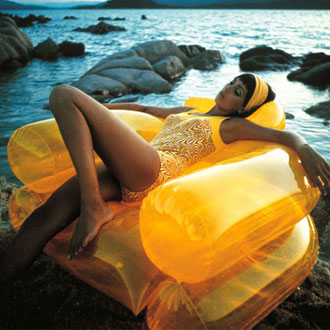“Pop Design ……”
Pop refers to the popular culture that emerged in the
1950s.
The members of the “Independent Group” which was
founded in London in 1952 were very interested (and also praised) the growth of
the popular consumer culture in America.
These members included the artist Richard Hamilton, the sculptor Eduardo
Paolozzi, the design critic Reyner Banham and the architects Peter and Alison
Smithson. Even American artists, such as
Andy Warhol, Roy Lichtenstein and Claes Oldenburg were being inspired by the
“low art” aspects of life that were in fashion in the 1960s, for example
advertising, packaging, comics and television.
The Good Design approach of the
Modern Movement was diminishing because
the designers developed a less serious approach to design. Industrial production in the 1960s did not
consider the Modern Movement’s saying “Less is More” as important anymore. The attitude changed to:
“use-it-today, sling-it-tomorrow”
Perfect examples of design that came out at that time
were the following disposable objects:
- The polka-dotted cardboard “Spotty” child’s chair of Peter Murdoch in 1963, and
- The PVC “Blow” chair of De Pas, D’Urbino and Lomazzi in 1967.
Agata Seredyn, (2012), Flux and Spotty Chair [ONLINE]. Available at: https://blogger.googleusercontent.com/img/b/R29vZ2xl/AVvXsEiVASw7J2Vzua2aPRl9Y9Fs4-kK2d2dBKh4d4y-6hPYFIz9fV64bGj_jEK5s-WYmi8LmD_TKARXkDOfP-1sdfMMDqVAq4GhhHn8tJr0aYV8HKpNW7JLDL-cqXa6JvuewwvjyyyTFFsnIvTl/s1600/petermurdoch.jpg
[Accessed 15 December 13]

bonluxat, (2013), Jonathan de Pas, Donato D Urbino and Paolo Lomazzi Blow Armchair [ONLINE]. Available at: http://static1.bonluxat.com/cmsense/data/uploads/orig/Jonathan_de_Pas%2C_Donato_D_Urbino_and_Paolo_Lomazzi_Blow_Armchair_6nq.jpg
[Accessed 15 December 13]

bonluxat, (2013), Jonathan de Pas, Donato D Urbino and Paolo Lomazzi Blow Armchair [ONLINE]. Available at: http://static1.bonluxat.com/cmsense/data/uploads/orig/Jonathan_de_Pas%2C_Donato_D_Urbino_and_Paolo_Lomazzi_Blow_Armchair_2vc.jpg
[Accessed 15 December 13]
Even glossy magazines and colour supplements that were
issued at that time were featuring cheap items that were not long-lasting, for
example paper dresses.
So, as one can imagine, the main materials that pop
designers were using were “plastics”. In
fact, by the 1960s many new inexpensive types of plastics and techniques
(including injection moulding) became available.
The simplicity that prevailed after the Second World
War came to an end. In fact, Pop Design
was associated with gleaming rainbow colours and distinct forms. At the same time, this brought about general
optimism which was re-inforced by economic growth and sexual freedom.
Pop Design was directed towards the youth market and
so, since the products had to be cheap, they couldn’t be much of good
quality. Gone were the days of producing
“timeless” modern classics!
Other Reference:
Book: Fiell, C.F and P.F, 1999. Design of the 20th Century. 2nd ed. Germany: Taschen

No comments:
Post a Comment